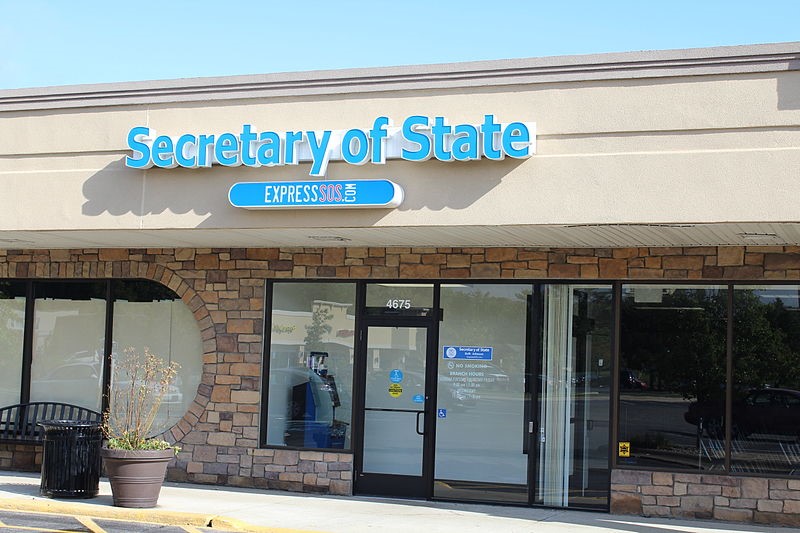Michigan could be 15th state to add nonbinary option to driver’s licenses
The Michigan Secretary of State is considering adding a nonbinary option for sex designation on state id’s and driver’s licenses. Michigan Secretary of State office is pictured Sept. 21, 2013.
Oakland University’s staff and students are pushing for visibility and change within our social climate, and the state is starting to follow with the possibility of gender-neutral sex designation.
Opportunity for a gender-neutral sex designation on Michigan identification could happen as soon as 2021, according to The Detroit News. Right now, the only options individuals have for sex designation are male or female.
Secretary of State Jocelyn Benson has tried to make this option possible in the past but couldn’t with the current system. Instead, Benson revised the current policy to make it easier for individuals to change their gender designation. Michigan was one of 22 states that required proof of sex reassignment surgery in order to change gender markers. Now, one can go to their local Secretary of State, fill out a form, take a photo and pay the corresponding fee.
With the passing of the Real ID Act by Congress back in 2005, the federal government allows for the gender-neutral option on state licenses and identification cards. There are currently 14 states that have the gender-neutral option.
Under the proposed change to better include transgender and nonbinary people in gender designations on driver’s licences, people typically can select “X” as an option to display next to “sex” on their driver’s license instead of “M” or “F.”
OU has already implemented policies of its own to continue their efforts in diversity, equity and inclusion. The recent Preferred Name Policy passed back in April 2018 allows for any student, staff member, or alumni to identify themselves within OU’s information systems with a preferred name in addition to their legal name. Proper identification and visibility have been a constant out cry from the transgender community according to an ACLU press release.
The Movement Advancement Project’s (MAP) “Understanding Issues Facing Transgender Americans” found that, “Only one-fifth (21%) of transgender people who have transitioned to living in accordance with their gender identity have been able to update all of their IDs and official records with the correct gender, and one-third (33%) had updated none of their IDs or records, according to the National Transgender Discrimination Survey.
“At the time of the survey, only 59% had been able to update their gender on their driver’s license or state ID; 49% had updated their Social Security record; 26% their passport; and just 24% their birth certificate. The survey results also confirmed what most transgender people already knew—that when the gender marker on an ID does not match the way a person dresses and lives their life, it exposes people to a range of negative outcomes, from denial of employment, housing, and public benefits to harassment and physical violence.”
Dr. Erin Meyers, associate professor of communication, stressed the importance of people being recognized as who they see themselves. She mentioned that it’s important for the individual to feel that they belong in this community instead of feeling removed.
“Are you going to get the kind of treatment that you need … turned away at a school if you’re not presenting the way your ID um says that you are?” Meyers said. “Those kinds of things are technically supposed to be illegal, but the rise of transgender visibility is really challenging that because some people who don’t agree with it are saying … ‘If you’re not presenting the way your birth certificate or your ID says, then we don’t have to pay attention to you.’”
Jessica Quandt, graduate assistant for the Gender and Sexuality Center (GSC), shares similar views.
“If [society] doesn’t see it then they don’t think about, they don’t care about it,” Quandt said.
She expressed that, the more visibility the LGBTQIA+ community receives, the more people will want to become educated about these topics. The GSC offers peer mentoring, learning sessions and Pride Month to the OU community.
The planned efforts for progression in equity, inclusion and diversity by OU are listed as Goal No. 4 in the university’s 2025 strategic plan.
Chad Martinez, director of diversity, equity and inclusion and Title IX coordinator, defines equity as the opportunity for one to live up their potential without barriers put up by others that would make one’s life more challenging. He said the advancement of at least one marginalized group helps people realize they may have preconceived notions, and the inclusion of those groups into the majority provides opportunities for people to interact.
“The more success people see with that the more able they are to break done stereotypes and unconscious bias,” he said.











